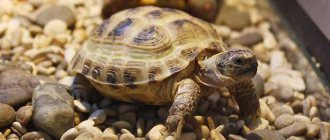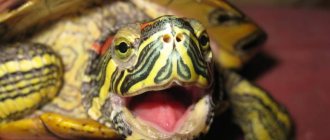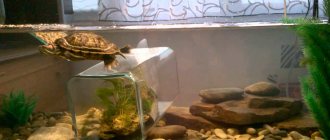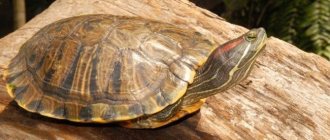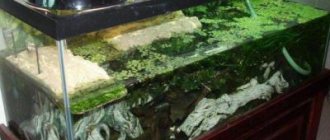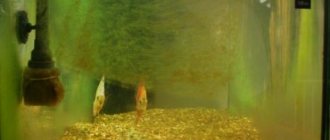Red-eared sliders are one of the most popular pets and are fun to watch and care for. These reptiles are unpretentious, beautiful, easy to tame, and have a funny behavior. Another advantage of reptiles is that red-eared turtles live at home for quite a long time, so the owner does not have to mourn the loss of a pet. Despite the fact that it is easy to keep yellow-bellied beauties in a terrarium, inexperienced owners often make gross mistakes that lead to a reduction in the life expectancy of red-eared turtles. To avoid such consequences, before purchasing, you should learn about how to care for turtles and how they differ from land turtles.
Habitat in nature
The red-eared turtle received its original name due to its distinctive external feature: two scarlet-orange spots stretch from the eyes to the neck of the reptile. The turtle’s second nickname is the yellow-bellied turtle, due to the fact that the creature’s abdominal shield is painted bright yellow.
The habitat of the red-eared slider in nature is America, so the variety is often called “American”. Reptiles live near rivers and cannot live without water, but land plays a significant role in nature for the red-eared slider. The lifespan of these reptiles is 30-40 years. Having acquired an exotic pet, the owner should know the nuances of keeping red-eared turtles at home so that the pet lives a long life.
Consequences of a long stay without water
If an aquatic turtle escapes from the aquarium or the owner loses sight of it, it will live for 1 to 3 days, after which serious health problems will begin:
- The pet can be injured due to falling or colliding with obstacles.
- It may get stuck in a tight place or a secluded corner, making it difficult to find the turtle right away.
- The surface of the shell begins to delaminate, and microcracks appear on the skin.
- The skin peels off, the surface fades.
- Fungi and other microorganisms penetrate into cracks, which leads to the development of inflammation and infectious diseases.
- When left outside the aquarium for a long time, the reptile becomes very lethargic and loses its appetite for a while.
If a red-eared slider is left without water for 4 days or more, it may die. To prevent this from happening, you need to keep the turtle carefully and not allow it to walk around the apartment for a long time, or especially on the street. If the turtle is lost and does not appear for several hours, it is better to begin an active search. The animal could simply get stuck or roll over and be unable to free itself.
To find it, you should go around all inaccessible places and also place basins of water in them. If your pet falls asleep, when he wakes up he will find containers to plunge into.
It is important to understand that the red-eared slider cannot live long without water. No less dangerous is the fact that she very actively climbs in different places, so she can get stuck in any cramp.
Description and general information
Turtles in a terrarium are a funny sight that is fascinating to watch for both adults and children. Caring for reptiles in captivity is not difficult, but before purchasing, you should get to know the pets better, learning the characteristics and subspecies of reptiles.
Description of the red-eared slider:
- The size of reptiles in captivity can reach up to 60 cm.
- The protective shell of an adult red-eared slider becomes slightly wrinkled.
- The famous spots from which the turtles got their name can be either scarlet or lemon
- The color transforms with age: small red-eared turtles are painted in emerald tones, older ones can acquire a black tint.
- The plastron of animals is intensely yellow with rounded markings.
Chinese Trionix
One of the few representatives of soft-bodied turtles. The shell does not have hard horny plates on the surface, and consists only of thick but soft skin.
The characteristic features of the structure include the following:
- The leathery shell is completely covered with small tubercles, by which experts can track the age of the reptile.
- The traditional color is represented by green-brown colors and a yellow border along the lower edge of the shell.
- In addition to all external features, the turtle is distinguished by its relatively small size. The weight of an adult rarely exceeds 4 kg.
- Very sharp horny ridges that completely replace teeth in reptiles.
- The structural features of the shell provided the Chinese turtle with a unique opportunity - full skin respiration. A sufficiently developed blood network under the skin allows the animal to stay under water for up to 15 hours.
- Very fast reaction to signs of danger and to the appearance of food in the visibility zone.
Thanks to their soft shell, reptiles easily burrow into the ground. This property should be remembered when organizing an aquarium with this variety of turtles.
Species of red-eared turtles
The popularity of yellow-bellied reptiles was given not only by their attractive appearance and easy care, but also by the variety of subspecies. Among the species of red-eared turtles, the following representatives are especially in demand:
- Trachemys scripta scripta – the turtles reach 27 cm in length and have a characteristic lemon spot that merges with the stripe on the neck. The plastron is yellow with spots.
- Trachemys scripta elegans - grows up to 28 cm. There is a wide red stripe on the head of reptiles.
- Trachemys scripta troostii - representatives stretch up to 21 cm. There is a yellow stripe and extensive chin lines on the head. There is a yellow line on each costal shield. The plastron is decorated with small black spots.
Land turtles
Living conditions, feeding and bathing
For land turtles, a terrarium is usually prepared, but if one is not available, an ordinary cardboard box or plastic container will do.
The bottom of the container is covered with clean hay or sawdust. It is not recommended to use soil or sand. In order for the turtle to periodically grind down its claws, it is worth placing several large stones in the terrarium.
The terrarium must be equipped with an infrared heater or incandescent lamp. To prevent the turtle from suffering from lack of sunlight, you should install an ultraviolet lamp.
Turtles do not really like attention to them and often hide. Therefore, you can build a “house” for them. You can make it from a flower pot cut lengthwise, half of which will become a shelter for your pet.
Land turtles love to eat vegetables (mashed carrots, zucchini), fruits (apples and others), dandelions and lettuce. Dandelions can be dried for the winter.
Turtles “drink” through their skin, so they should be bathed at least once a week. For this, the water temperature should be about +32C, and its level should be up to the middle of the shell.
Land turtles need to be cared for especially carefully during their molt. To do this, add baking soda to the water while bathing (one teaspoon per liter of water). During molting, the pet bathes in this solution no more than twice. Do not lubricate the shell with lotions or oils. They only clog the pores on the skin, but have practically no benefit.
In summer, at temperatures above +20C, land turtles can be walked. A green lawn with dandelions and clover growing is suitable for this.
Having created all the necessary conditions for your pet, he will feel good and comfortable throughout his many tortoise years. Do not forget that an animal is still not a toy, but a creature that needs care and attention.
Maintenance and care
Keeping a red-eared turtle at home is simple, and even an inexperienced person can do it, but certain nuances still need to be observed. The pet’s health and life expectancy depend on them, so the first thing you need to do is organize a spacious terrarium for the reptile. We’ll talk further about what kind of aquarium is needed for a red-eared turtle and what should be in it.
Arrangement of the terrarium
A red-eared turtle at home will grow and develop normally in a terrarium with a volume of 150 liters or more. The height must be greater than the width so that the turtle can turn over freely. The liquid level should be such that a reptile standing on its hind legs could stick its muzzle out of the water.
An aquarium for a red-eared turtle must be equipped with an island with a gentle bank so that the pet can easily climb onto land. When placing decorations, preference should be given to driftwood, previously soaked and treated to remove dirt and bacteria, or non-toxic plastic elements. There is no need to plant living flora - this is exactly what red-eared turtles eat, since not a trace of the plants will remain. When using a substrate, choose a large, smooth soil.
In addition to sushi, 40 and 60 W bulbs are installed in the turtle aquarium at a distance of 25 cm. Otherwise, the light will disturb the pets. Reptiles need an ultraviolet lamp to produce vitamin D3, so experienced aquarists use Repti Glo 5 and 8 devices. The source of ultraviolet rays is located at a distance of 40 cm, otherwise the pet will get burned.
Read more about what kind of aquarium is needed for a red-eared slider in a separate article (link).
Water environment
Turtles spend most of their time in water, so it is important to pay attention to the aquatic environment in the terrarium. Reptiles prefer clean, clear liquid, so installing a filter in the container is a must.
The liquid used to fill the terrarium is settled, without chlorine and harmful impurities. The water temperature for red-eared turtles is 22-28C. To maintain the number of degrees you need a heater and a thermometer. The fluid is renewed weekly, replacing 1/3 of the volume. It is important to note that the well-being and life of reptiles depends on the attention of the owner in this matter.
Walks
Owners of a red-eared slider, no matter how cute the reptile may seem, should know that they should not let their pets sit on the floor. Turtles tend to get scared in a new place, so they can bite and painfully scratch their owner. After contact with reptiles, you should wash your hands, since pathogenic bacteria accumulate on the shell of animals.
In the summer, the red-eared turtle is taken for a walk, where the pet receives natural ultraviolet rays and feasts on fresh grass. A place for walking is chosen away from roadways, with a flat, clean lawn. The walk time is 30 minutes, the temperature outside in the shade should be 20C, otherwise the pet will become exhausted. You should take a bowl with clean water with you so that the turtle can drink.
Feeding
Adult reptiles are fed 2-3 times a week, young pets are fed daily. The red-eared slider's diet should consist of the following foods:
- Live lean fish: blue whiting, gobies, etc.
- Raw meat.
- Various types of insects: crustaceans, bloodworms, daphnia, etc.
- Squid, shrimp, snails, frogs.
- Vegetation: lettuce, cabbage, dandelion and other plants.
- Vegetables: carrots, apples, cucumbers.
It is strictly forbidden to feed your pets cheeses, lamb, flour and bakery products, pork, fruits and other fatty and human products. To prevent diseases, turtles are given calcium supplements and vitamins.
Read more about what to feed a red-eared slider at home in a separate article.
Special equipment
Far from wild nature, temperature conditions will have to be created artificially using special equipment. To maintain a comfortable temperature you will need:
• UV lamp and lamp for heating sushi; • 100 W water heater (power is relevant for aquariums with a volume of 100 liters and increases with increasing volume); • thermometer.
The UV lamp normalizes the absorption of calcium and vitamin D, and also prevents the development of rickets, which prevents the proper development of bones. The lamp is placed at a distance of 40 cm from the turtle and changed 2 times a year when the power is reduced.
Heating water for turtles using a heater is the easiest and most effective way to maintain optimal temperature conditions in the aquarium. It has no reliable analogues. Alternative options are only valid in 2 situations:
- temporary power outage;
- The heater has failed and needs urgent replacement.
For a turtle left in an aquarium without a heater, you can maintain a comfortable water temperature in the following ways:
- Adding warm water. It is permissible to add no more than 20%. Do not pour tap water containing chlorine. For your pet's safety, be sure to boil the water.
- Using a table lamp. Move the lamp closer to the aquarium and point the lamp at the glass, aiming the light at the area below the water level.
Please note that these solutions are only valid as a temporary replacement and do not replace the purchase of a new heater if it breaks. Stable temperature conditions are important for a turtle’s well-being, so be sure to make sure you have all the necessary attributes for its maintenance before making a purchase.
Stability of the temperature regime is important for the turtle’s well-being, so be sure to ensure that you have all the necessary attributes for its maintenance before making a purchase.
Reproduction
In red-eared turtles, reproduction occurs in the spring. Males are capable of reproducing from the age of 4, females from the age of five. To see how reptiles lay eggs, the owner should prepare a breeding container:
- The water level should not exceed 10 cm.
- A container is installed on an island of land where turtles lay their eggs.
It is important to note that only a pair of turtles of the opposite sex should be present in the terrarium during the breeding season, otherwise the males will fight. The turtles mate in an interesting way: the male swims up to the female, tickles her with his claws and pokes her with her muzzle.
After mating of the red-eared turtles has occurred and the expectant mother has laid eggs in a dug hole, the container with the offspring is transferred to the incubator. The optimal temperature is 27-30C, and it is noted that at 30C females are born, at 27C - males. After about 2 months, the turtles are born, but the babies cannot be released to adult reptiles, since yellow-bellied pets do not shine with parental love and can attack.
How to determine gender
In order for the breeding of red-eared turtles at home to be successful, every owner must know how to calculate the sex of the pet. To do this, the appearance of reptiles is compared, identifying differences that will indicate gender.
To understand how to find out the gender of a red-eared turtle, you need to be able to find the differences between a male and a female:
- Females are slightly larger than males and have a rounded head shape. Males have an elongated head.
- Males have a depression on the abdomen; girls do not have such a depression. The shell of male representatives is elongated, while that of females is rounded.
- Female turtles have short claws, while males have long and sharp claws.
- In male representatives, the tail is wider and thicker, and the cloaca is located at a distance from the shell. In girls, the cloaca is star-shaped and located close to the shell.
How to determine the sex of a red-eared turtle
How to find out age
Unfortunately, sometimes even store salespeople are unable to accurately tell the age of a red-eared turtle, so owners have to deal with this issue on their own. The following data will help you find out the age of a red-eared turtle:
- 2 years – females 8-9 cm, males – 7-8 cm.
- 3 years – females 10-14 cm, males – 8-10 cm.
- 4 years – females 13-16 cm, males – 12-14 cm.
In addition to calculating age based on pet size, you can find out the approximate number of years in the following way:
- Shell color - in young turtles the coating is green. After 4 years of life, the shell begins to darken; in older reptiles the cover is almost black.
- Rings – rings are formed on the shell when reptiles reach one year, 2-3 rings are added every six months. After 4 years of life, the ring appears once a year. By counting the number of rings, you can roughly estimate the age of the turtle.
Interior
The main element of the interior is its island and a gentle ladder connecting it to the water. So that the turtle can easily climb onto the island, the ladder should be moderately rough. You can purchase a special mat at a pet store. Everything else is a matter of taste, but you need to make sure that there is no fine gravel or poisonous plants in the aquarium, otherwise the turtle may eat them and get poisoned.
An interior made of artificial plants is also not very suitable, since she can easily bite off a piece and choke.
The availability of the required amount of water is very important. There should be enough of it for the turtle to swim, but not too much
As a rule, this depends on the size of the turtle itself.
You cannot add any neighbors to it, such as fish, snails and other representatives of the underwater world, since it will simply eat them.
Do you need neighbors?
The behavior of red-eared turtles in relation to other underwater inhabitants and relatives cannot be called friendly. Reptiles tend to enter into conflicts with each other, and pugnacity especially manifests itself in adulthood. Given this temperament, it is recommended to keep turtles separately from relatives, or provide pets with a spacious terrarium with partitions.
Tips for keeping two or more reptiles in one container:
- Pets must be the same size and age.
- You cannot keep two males in a terrarium.
- Each individual should have personal space and a rest area.
It is important to note that it is not recommended to keep frogs, lizards and snakes together with turtles, as these creatures are perceived by reptiles as food.
Amount of water
Let's now figure out how much water to pour into the turtle's aquarium. Aquariums for turtles are divided into 2 types, some of them have a glass shelf, which is decorated like a piece of land, and on which the turtle climbs to bask under the light of an incandescent lamp, while some do not have such a shelf.
With the first type, everything is simple - the amount of water must correspond to the shelf, the water level must be a couple of millimeters below the shelf so that the turtle can freely climb onto land and return to the water.
If the aquarium is not equipped with a shelf, the volume of water should be calculated based on the size of the turtle and the number of individuals that live in the aquarium. The general rule followed by turtle breeders is that the volume of the aquarium should be 4 times the length of the turtle. Thus, if the size of your turtle is 10 cm, a 40 liter aquarium will be enough, which should be filled with water from 1/3 to half the capacity.
If the aquarium contains two individuals, then its size should be increased by about one and a half times. It is imperative that an aquarium for an aquatic turtle have an island of land, approximately 20% of the volume of the entire aquarium.
Note! The distance from the water to the top edge of the aquarium must be at least 15 cm so that your pet cannot escape. In any case, if it is possible to purchase a larger aquarium, you should do so; in such a home the turtle will have more space, the water will be less polluted, and the appearance of a large aquarium will be more presentable
In any case, if it is possible to purchase a larger aquarium, you should do so; in such a home the turtle will have more space, the water will be less polluted, and the appearance of a large aquarium will be more presentable.
We described in detail how to set up an aquarium for an aquatic turtle here.
Diseases
Despite the endurance and resilience of red-eared turtles, sometimes due to errors in keeping the reptiles get sick and die. Knowledge about common turtle ailments and treatment methods will help you avoid such consequences:
- Pneumonia - the disease develops due to being kept in cold water or lack of food. Symptoms include hoarse breathing, lethargy, weakness and pallor of the mucous membranes. Treatment is carried out using an injection of Baytril 2.5% - 0.4 ml/kg into the brachial muscle.
- Bone ailments - if white spots on the shell and detachments are detected in a red-eared turtle, we can conclude that there is a fungal infection. Pets are treated with Clotrimazole ointment, treating damaged areas.
- Lack of calcium - with this problem, reptiles' shell peels off. The deficiency can be eliminated by giving pets small fish with bones and calcium supplements.
By following the maintenance rules, red-eared turtles will not be affected by any diseases.
What to feed a freshwater turtle
Having dealt with the question of how to care for a turtle, it’s time to find out what reptiles eat. The diet largely depends on the age of the animal - very young children receive all the necessary nutrients from a special gall sac, which is located on the plastron. While the cub is feeding on the gall sac, it does not need additional feeding. Young reptiles can be fed small crustaceans, vegetables and, of course, specialized food with calcium supplements. During this period, the shell is actively growing, and the lack of the main element for its structure can negatively affect the health of the turtle.
What do aquatic turtles eat? Plant food, animal food and artificial food. At the same time, food from a pet store should make up about 50% of the total diet. The diet should be varied - lettuce, dandelions, clover, algae, mussels, shrimp, snails, raw fish and chicken. The portion depends on the animal's appetite. Young animals should eat at least once a day. Adults can be fed once every 2-3 days.
What you need to know before buying
Growing and breeding red-eared turtles in captivity is not difficult, so even beginners can acquire reptiles. However, before purchasing pets, you should learn not only about maintenance issues, but also other nuances. During the winter, these turtles do not hibernate and spend most of their lives in water, so it is important to monitor the cleanliness and parameters of the liquid in the terrarium. When buying tiny reptiles, the owner must understand that the baby will soon grow up and will need a spacious container to keep it, otherwise the turtle will get sick.
Red-eared turtles are funny and interesting pets that, instead of trouble, bring only joy and tenderness to their owners. Considering the attractiveness, endurance and unpretentiousness of reptiles, as well as how long red-eared turtles live, even an inexperienced owner will be able to raise and reproduce turtles at home, following the rules and recommendations for care.
Island
The land in the aquaterrarium must satisfy the following conditions:
- Sufficient dimensions for keeping reptiles.
- No cutting surfaces or protruding parts.
- Rough surface of the ladder leading to the island. If the surface is covered with pebbles for better grip on the paws, then make sure that the turtle does not swallow the fallen pebble.
- The ability to support the weight of a turtle without capsizing.
- Dryness. On land, the reptile warms itself and dries, so water should not get on it.
- Position yourself so that the turtle does not escape over the top edge of the terrarium.
- Warm. The optimal temperature (30 - 32 degrees) is maintained by two lamps (UV and heating) located above the land. The water should be cooler than the sand on the island.
- Safe material that does not emit toxic substances. Don't make an island out of cheap plastic and foam.
- Place the ladder in such a way that the turtle cannot get stuck anywhere.
You can make a piece of sushi yourself or buy it at a pet supply store.
Purchasing Tips
It is advisable to purchase red-eared turtles in early spring. There will be a summer period ahead, during which it is easy to adapt the kids to new conditions, provide them with walks and exposure to ultraviolet light.
Autumn amphibians tend to adapt less well and grow more slowly. Possible development of pathologies - autominosis, rickets, pneumonia.
It is necessary to choose a healthy individual. The shells must be hard, without chips or signs of deformation. Cracks and spots on the head and skin are unacceptable.
Signs of dehydration include closed or sunken eyes. This is also worth paying attention to. A whitish coating and neoplasms are unacceptable in the mouth. There should be no wounds or signs of injury on any part of the body.
It is unlikely that you will be able to determine the sex of young turtles on your own, but if this question is important, then you can pay attention to the claws, tail and notch on the plastron.

